- Flexural and durability performance of alkaline resistance glass fiber and basalt fiber in fiber reinforced concrete
D. Mythilia, R. Murugesanb and S. Christian Johnsonc,*
aAssistant Professor, Department of Civil Engineering, Excel Engineering College, Namakkal - 637303. Tamil Nadu, India
bPrincipal(Retd), Professor, Department of Civil Engineering, Government College of Engineering Erode, Tamil Nadu, India
cProfessor, Department of Civil Engineering, Erode Sengunthar Engineering College, Erode, Tamil Nadu, IndiaThis article is an open access article distributed under the terms of the Creative Commons Attribution Non-Commercial License (http://creativecommons.org/licenses/by-nc/4.0) which permits unrestricted non-commercial use, distribution, and reproduction in any medium, provided the original work is properly cited.
Concrete has unique properties to make things in any shape. However, the strength of the concrete to support is weak in tension and good in compression. To improve the tension force carrying capacity, the concrete might get some fibrous material as additional reinforcement in concrete. This addition can improve the load-carrying capacity, uniform stress & strain distribution to the entire cross-section, good bonding of ingredients, etc. This research paper deals with glass and basalt fiber in mono and hybrid form in M30-grade concrete. The glass and basalt fiber of 1.5% volume fraction possesses good behaviour in mechanical properties tests in mono form. When it is hybridization, 0.75% of each fibers combination has good strength in mechanical properties. The compressive strength has been increased up to 11%, tensile strength capacity has been increased up to 12.5% and the modulus of rupture has been increased by about 17.4% due to the hybridization of fibers. Similarly, the static load proves the specimen with fibers has a better resistance against the applied load and has less deflection corresponding to the ultimate load. The stress-strain behaviour obeys Hook law. The durability behaviour of the concrete specimen also has been improved. The performance assessments taken into account for the hybrid fibre reinforced concrete mixes are as follows: modulus of rupture, flexural behaviour of beams, split tensile strength, acid, sulphate, and chloride attack resistance. These parameters assess the mechanical and durability properties of the concrete mixes.
Keywords: Glass fiber, Basalt fiber, Hybridization, Mechanical properties, Static load test, Durability properties, SEM analysis.
The purpose of the test was to examine the static and impact qualities of the "green" Ultra-High Performing Hybrid Fibre reinforcement concrete (UHPHFRC). The impact resistance of the concrete was increased when the long steel fibers were used [1]. The static properties of basalt-polypropylene fibers were carried out on the standard specimen. From the test results and the SEM analysis, the conventional specimen failed due to being brittle, but the fiber specimen had a ductile failure [2]. This study examines polypropylene (PP) fiber that has plaster in place of rice husk ash (RHA). Flexural strength, abrasion test, and water absorption tests were conducted as per standards. The PP fiber of 0.6% and the 15% of RHA combination has performed well in all the tests [3]. The optimum content of fibers has been found such that steel is 0.8% and PP is 0.1% from the experimental part and the simulation has been performed using Finite Element Analysis. Both the experimental and numerical analyses have a good relationship in their results [4]. The uniaxial compression and three-point loading tests were performed to find the impact energy of hybrid fiber reinforced concrete using PP and PVA fiber hybridization [5]. This study's experimental portion involved hybrid fiber concrete that was reinforced, which was reinforced using steel fibers that were long, tiny, and hooked. The outcomes were compared to those of regular concrete [6]. This study focuses on developing hybrid engineered cementitious composites (HECC) and finding their performance under different states of loading conditions [7]. Research work concentrates on studying the crack resistance performance of concrete using steel fiber, reinforcing in self-stressing concrete under bending test. The performance was increased significantly [8]. The focus of this pilot investigation is on the Ultra high-performance concrete with fibre-reinforced deck specimen' static and flexural performance [9]. The focus of the research is on the structural properties of hybridized polymer-reinforced concrete beams. The fibers are placed in the tension zone of the beam and the curvature, deflection, ductility and crack width are analyzed [10]. In order to improve the tensile qualities of concrete, this study explains how to employ ceramic waste powder in place of some of the cement and coir fibres as a natural fibre reinforcement. Results show that combining ceramic waste powder replacement with coir fiber addition yielded the strongest concrete compared to control samples [11]. The effect of MgO content on the behavior of chromium in glass-ceramics prepared from stainless-steel slag, showing how Cr-spinal nanocrystals evolve and migrate into the diopside crystal phase. The study provides insights into enhancing chromium fixation in waste materials for environmentally friendly and value-added applications [12]. This study investigates enhancing the mechanical properties of polymer concrete by using modified polyetheramine particles as aggregates, resulting in improved bond strength and durability [13]. This study investigates the concrete mechanical quality and flexibility strength by adding glass fibers resistance to alkali to the mixture. The fibers greatly improve the concrete's flexural and compressive strengths, extending its durability under tensile loads. This method provides a substitute for conventional steel reinforcing, which could save material consumption and avoid material congestion in reinforced concrete structures [14]. To assess the workability, compressive and tensile strengths effect of alkali-resistant glass fibers are suggested. For improve durability and properties to determine the best fiber dosage into considerations, and 0.8% to 2.4% by weight. The material performance affected by the fact that glass fibers not only improve the tensile strength of concrete but also increase its sorptivity and water absorption [15].
The mix design has been prepared for the concrete of grade M30 as per IS10262:2019 [14]. Cement used is fulfilled IS8112:2013 [15], the coarse and fine aggregates used is fulfils IS383:1970 [16], IS2386: Part I & Part III [17, 18]. Table 1 displays the mix proportion of fiber reinforced concrete of grade M30 to fulfil IS 456:2000 recommendation [19]. The volume fraction of fiber has been varied between 0.5% to 2% for cement weight. Based on glass and basalt fiber volume fraction, a total of 12 mixes have been prepared. In that, 3 mixes are hybrid fiber reinforced concrete.
M30 grade concrete gains better mechanical qualities like the stiffness of dissection, split tensile strength, and compressive strength when glass and basalt fibers are added. The fibers enhance the concrete's resistance to cracking and increase its durability, especially against acid, sulphate, and chloride attacks. In hybrid form, the fibers complement each other, further enhancing the overall performance of the concrete mix.
Scanning Electron Microscopy (SEM)
The surface morphology for both conducting and non-conducting samples has been assessed using the Field Emission Scanning Electron Microscope (FE-SEM) equipped with an in-lens and BSD detectors. With an energy resolution of less than 126 eV, the X flash detector provides an accurate qualitative analysis of elements. An EDS detector is attached. To eliminate any moisture, the sample was baked at 100 degrees Celsius for one hour. These samples next go through the gold-palladium coating process, which reveals their precise and distinct form. Only the samples remained after that for examination. FE-SEM is used for detailed surface morphology analysis by employing in-lens and BSD detectors. Prior to analysis, samples are oven-dried, coated with gold palladium, and analyzed using an attached EDS detector for qualitative elemental analysis, ensuring clear and precise morphology observation.
Compressive Strength
The Indian Standard (IS: 516 – 1959) [15] requirements were strictly adhered to in performing the compression test on the cylindrical and cylinder specimens. The standard test for the compressive strength on a cube sample is shown in Fig. 1. The compression test on the concrete specimens revealed that the addition of glass and basalt fibers, individually and in hybrid form, increased the compressive strength compared to conventional concrete. The hybrid fiber reinforced concrete showed the highest improvement in compressive strength, indicating a synergistic effect between the two types of fibers.
Split Tensile Strength
The split tensile exam is one of the indirect strain test procedures used to determine the tear strength of masonry. For cylinder specimens, the split tensile force test is performed using the compression testing apparatus. Following IS 5816: 1999 [20], the specimens have been cast and inspected. The standard test for cylindrical samples under the split Tensile Strength test is shown in Fig. 2. Finding the tensile strength of concrete is crucial for evaluating its capacity for withstanding tensile pressures and avoiding breaking. This is why the divided tensile strength test is used. It is conducted on cylindrical concrete specimens by applying a diametrical compressive load to the specimen using a compression testing machine and then measuring the tensile strength based on the applied load and specimen dimensions.
Modulus of Rupture
The term "modulus of rupture" refers to the highest fiber stress determined during the test specimen's failure. Additionally, it is a surrogate indicator of the material's tension strength. The Flexural Strength Test is carried out per IS 516-1959 standards [21]. There have been cast beams measuring 100×100×500 mm in the flexion test. The standard test for prism specimens during the condition of modulus of fracture strength test is shown in Fig. 3.
Flexural Behavior of Fiber-Reinforced Concrete Beams
This experimental programme involves the casting and testing of four reinforced concrete beams with a length of 2.0 metres. A simply supported 1.8 m span is used to evaluate each beam. In order to support a minimum ultimate load of 35 kN, the beam is constructed under a reinforced section. Tensile reinforcement for the beam is provided by two 10 mm diameter bars at the bottom, and shear reinforcement is provided by two additional 8 mm diameter bars at the top. Six mm diameter stirrups are utilised at 100 mm centre to centre to hold the reinforcements in place. There was a use of Fe 500 reinforcement bar. In a static stress test, Fig. 4 shows a typical image of a beam specimen.
Acid Attack
The concrete cubes are cured for 28 days in regular water before being submerged for 90 days in a 5% hydrochloric acid (HCl) solution diluted by the weight of water. This process is done to examine the concrete's resistance to acid. The solution is changed every fifteen days since its concentration decreases. The specimens are tested at intervals of every thirty days, and the submerged specimens are visually inspected for signs of acid-induced concrete damage. The two types of tests—weight loss and compression strength loss—are carried out on the submerged specimen [22, 23].
Figure 5 displays the typical image of the cube specimen after 90 days of the acid attack test.
Sulphate Attack
The cube specimen is subjected to the sulfate attack examination, after which it is submerged in regular water curing for 28 days. Following 28 days of water in the cure process the specimens were submerged for 90 days in a 5% sodium sulfate (H2SO4) solution that had been diluted with water that had been distilled. Every fifteen days, the solution is changed to maintain the desired concentration level. The specimens are examined at intervals of every 30 days to track any weight loss and strength loss brought on by sulfate attack [22, 23]. The usual shape of a cube specimen following a 90-day corrosion test is shown in Fig. 6.
Chloride Attack
The cube specimen is subjected to the chlorine attack test, and after 28 days, its cubes are submerged in regular water to cure. The specimens in question are submerged in a 5% sodium chloride (NaCl) solution diluted with distilled water for ninety days following a twenty-eight-day water curing procedure. Every fifteen days, a new solution was added to preserve the concentration level. The specimens in question are examined at intervals of every 30 days to track any reduction in weight and diminished strength brought on by chloride assault [20, 21].
Figure 7 displays the typical image of a cube specimen after 90 days of chloride attack test.
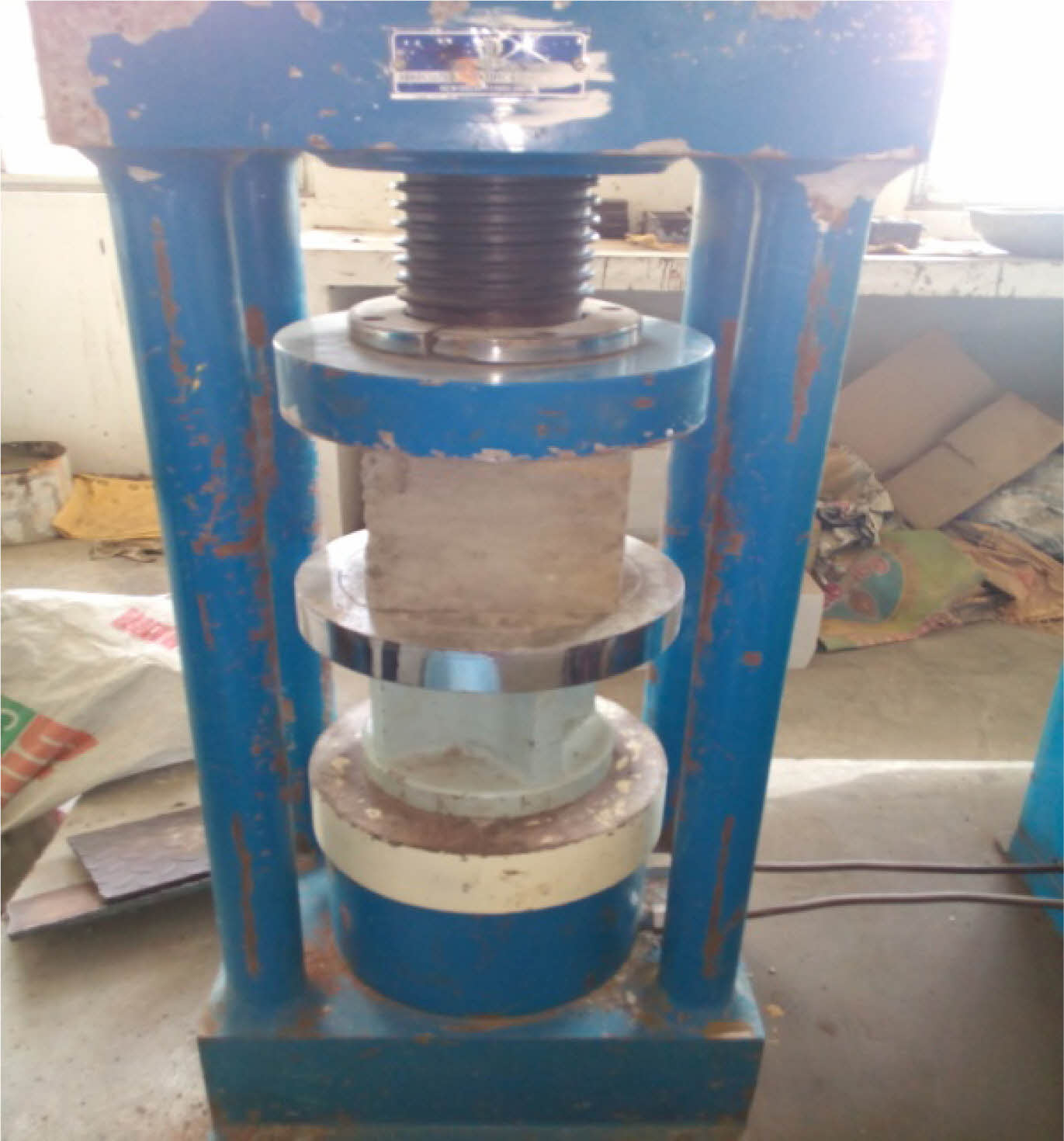
|
Fig. 1 Compressive strength test. |
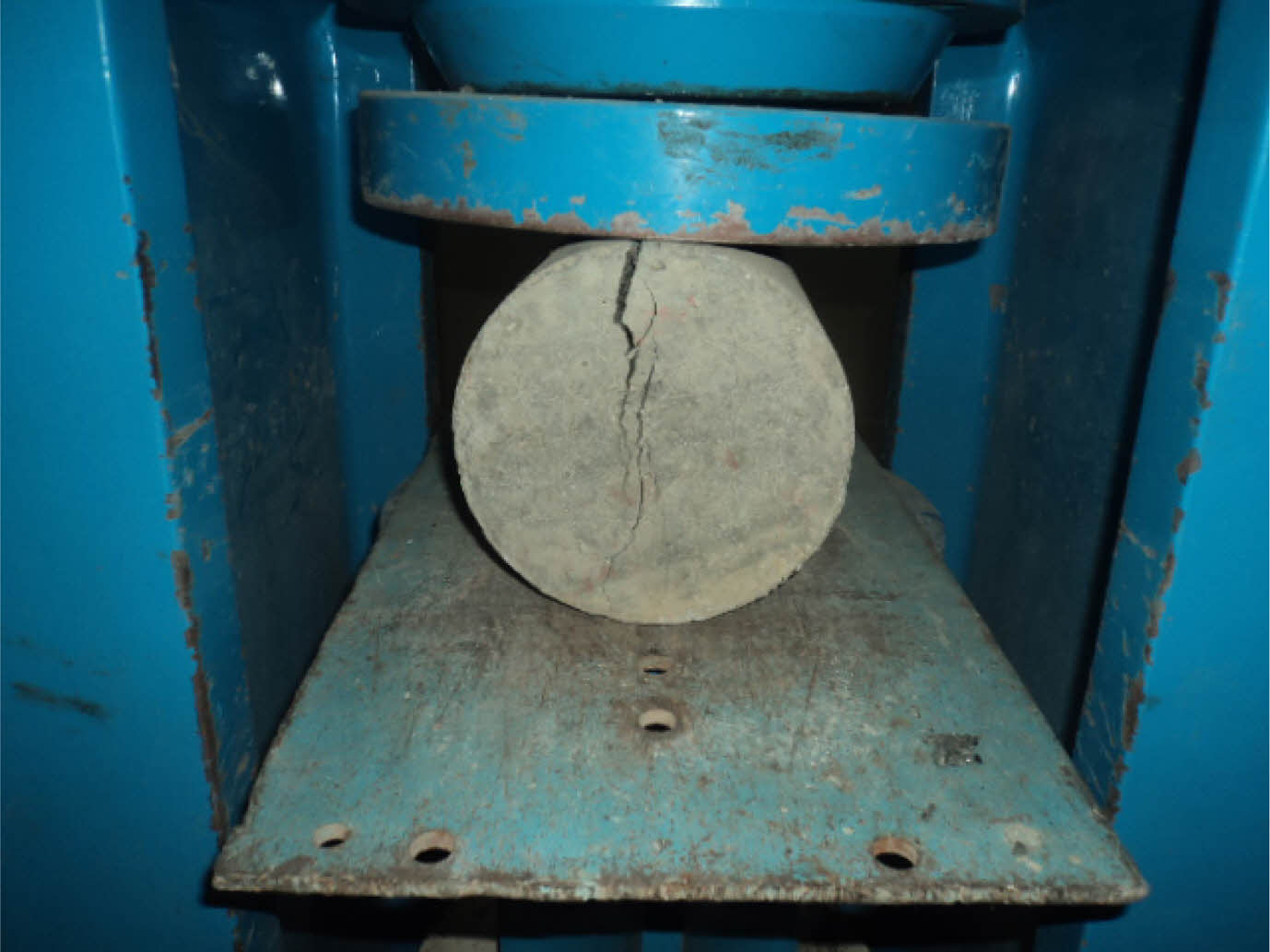
|
Fig. 2 Split tensile strength test. |

|
Fig. 3 Modulus of rupture strength test. |
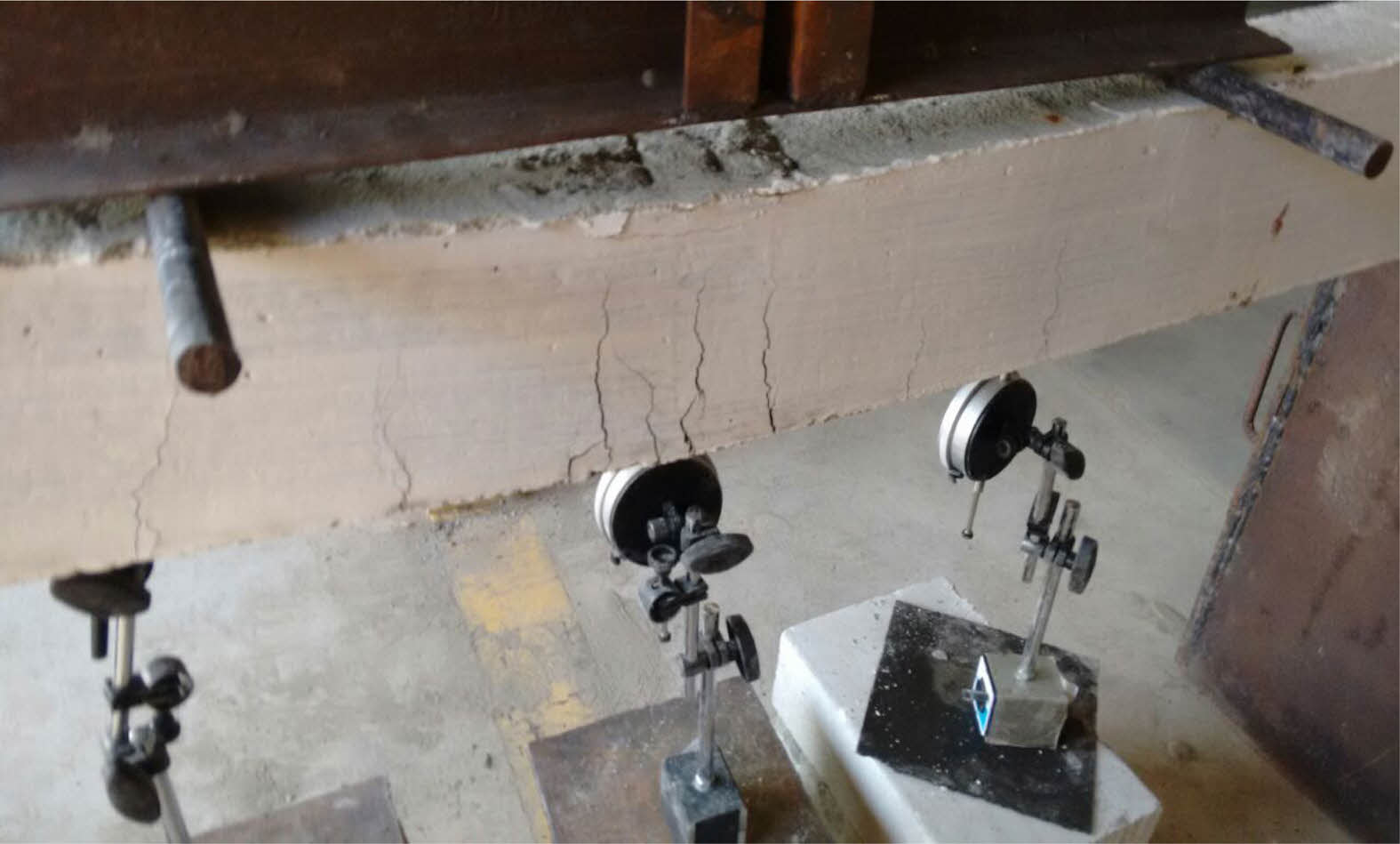
|
Fig. 4 Beam specimen under static load test. |
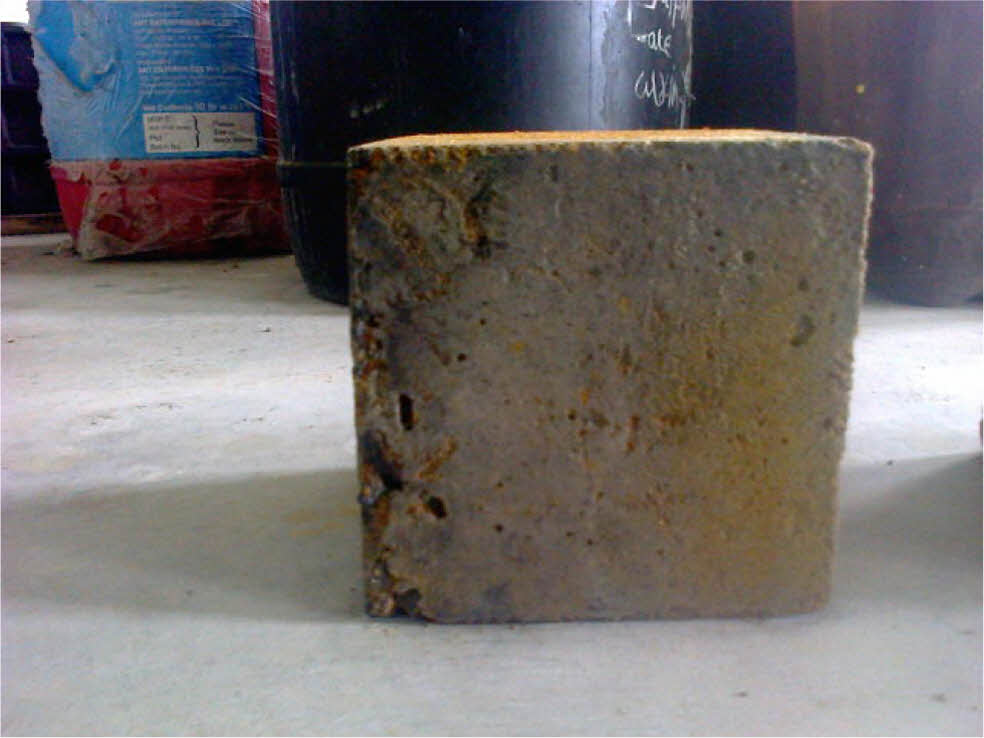
|
Fig. 5 Typical surface of the cube after 90days of acid attack. |

|
Fig. 6 Typical surface of the cube after 90days of sulphate attack. |
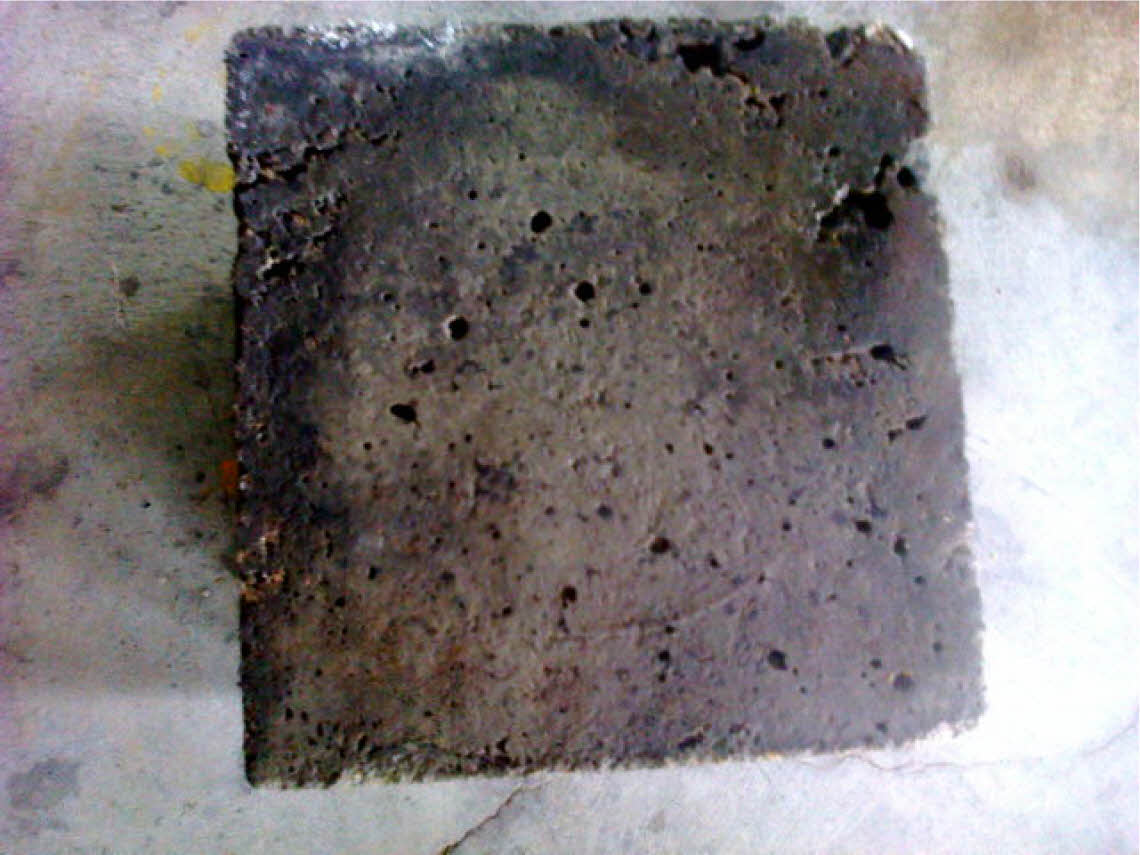
|
Fig. 7 Typical surface of cube after 90days of chloride attack. |
Scanning Electron Microscopy (SEM)
Figure 8 displays the typical morphology of hybrid fiber reinforced concrete. The image shows the fibers making good bonding with the concrete.
Compressive Strength
After 28 days of water curing, the CC specimen's elastic modulus is 34.6 MPa. Similarly the CG0.5, CG1.0, CG1.5, CG2.0, CB0.5, CB1.0, CB1.5, CB2.0, CG0.5B1.0, CG0.75B0.75 & CG1.0B0.5 has the values of compressive strength as 35.8, 36.7, 37.6, 37.3, 35.6, 36.4, 37.1, 36.9, 37.5, 38.4 & 37.9 MPa. The values of compressive strength are 3.5, 6.1, 8.7, 7.8, 2.9, 5.2, 7.2, 6.6, 8.4, 11 & 9.5% more than the strength for the CC specimen. 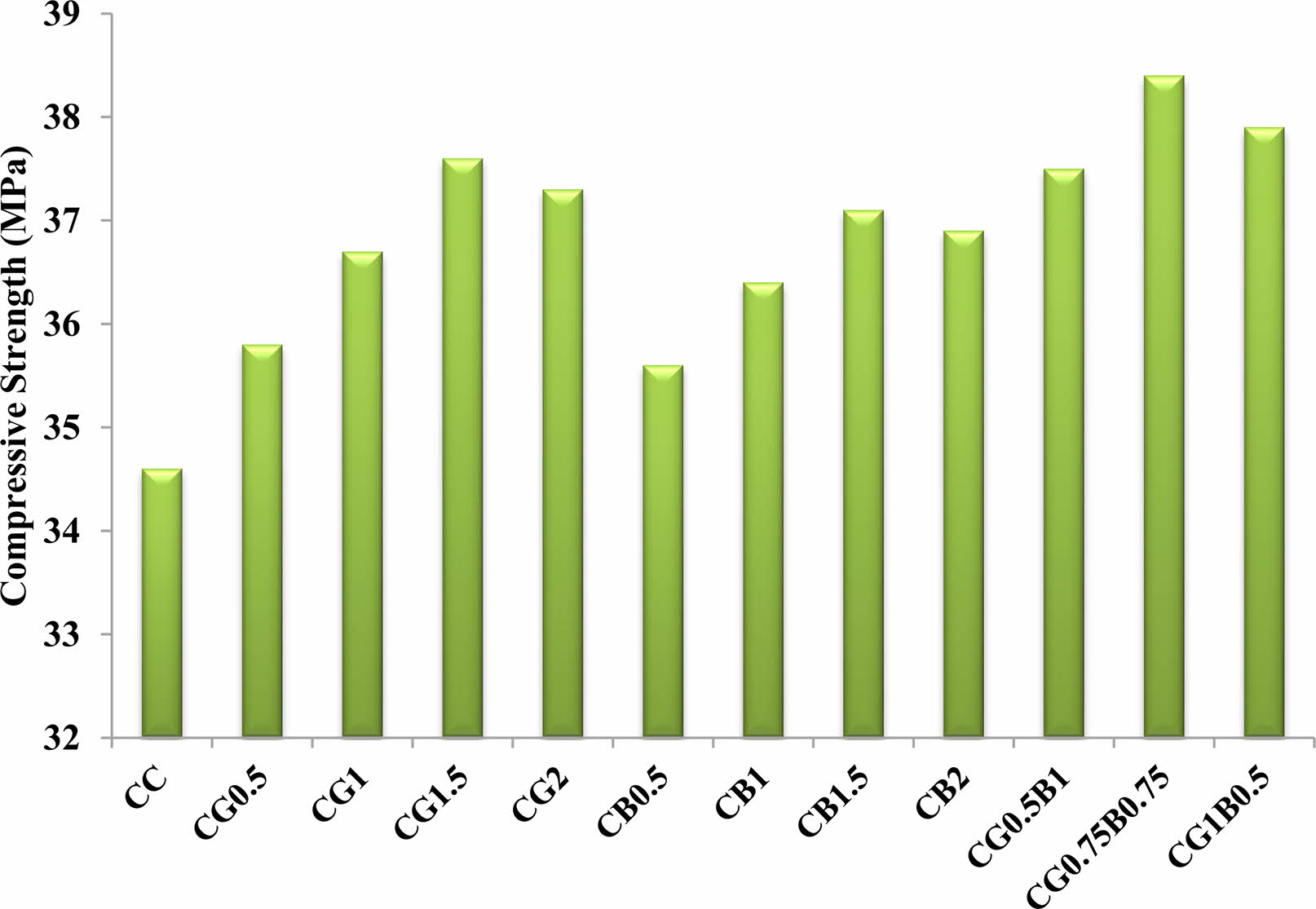
Split Tensile Strength
After 28 days of water curing, the CC specimen's split tensile load is 3.92 MPa. Similarly the CG0.5, CG1.0, CG1.5, CG2.0, CB0.5, CB1.0, CB1.5, CB2.0, CG0.5B1.0, CG0.75B0.75 & CG1.0B0.5 has the values of split tensile strength as 4.23, 4.36, 4.42, 4.38, 4.19, 4.26, 4.34, 4.31, 4.32, 4.41 & 4.31 MPa. The values of split tensile strength are 7.9, 11.2, 12.8, 11.7, 6.9, 8.7, 10.7, 9.9, 10.2, 12.5 & 9.9% more than the strength for the CC specimen.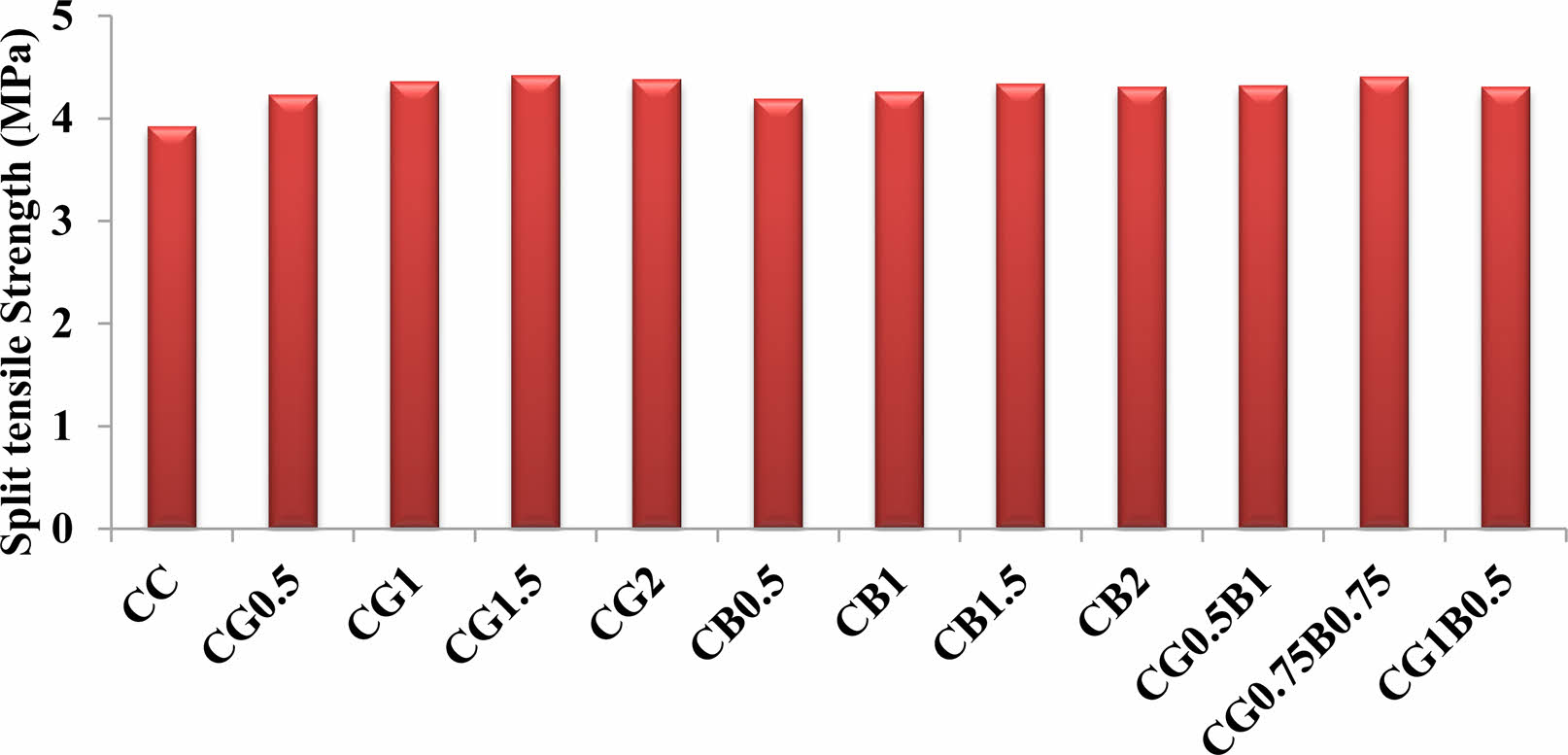
Modulus of Rupture
The point of rupture modulus parameter of the CC specimen has a value of 4.19 MPa after 28 days of water curing. Similarly the CG0.5, CG1.0, CG1.5, CG2.0, CB0.5, CB1.0, CB1.5, CB2.0, CG0.5B1.0, CG0.75B0.75 & CG1.0B0.5 Having broken modulus parameter values as 4.19, 4.38, 4.42, 4.78, 4.38, 4.26, 4.34, 4.58, 4.31, 4.78, 4.92 & 4.86 MPa. The values of modulus of rupture strength are 5.5, 10.3, 14.1, 9.3, 1.7, 3.6, 8.4, 2.9, 14.1, 17.4 & 16.0% more than the strength for the CC specimen.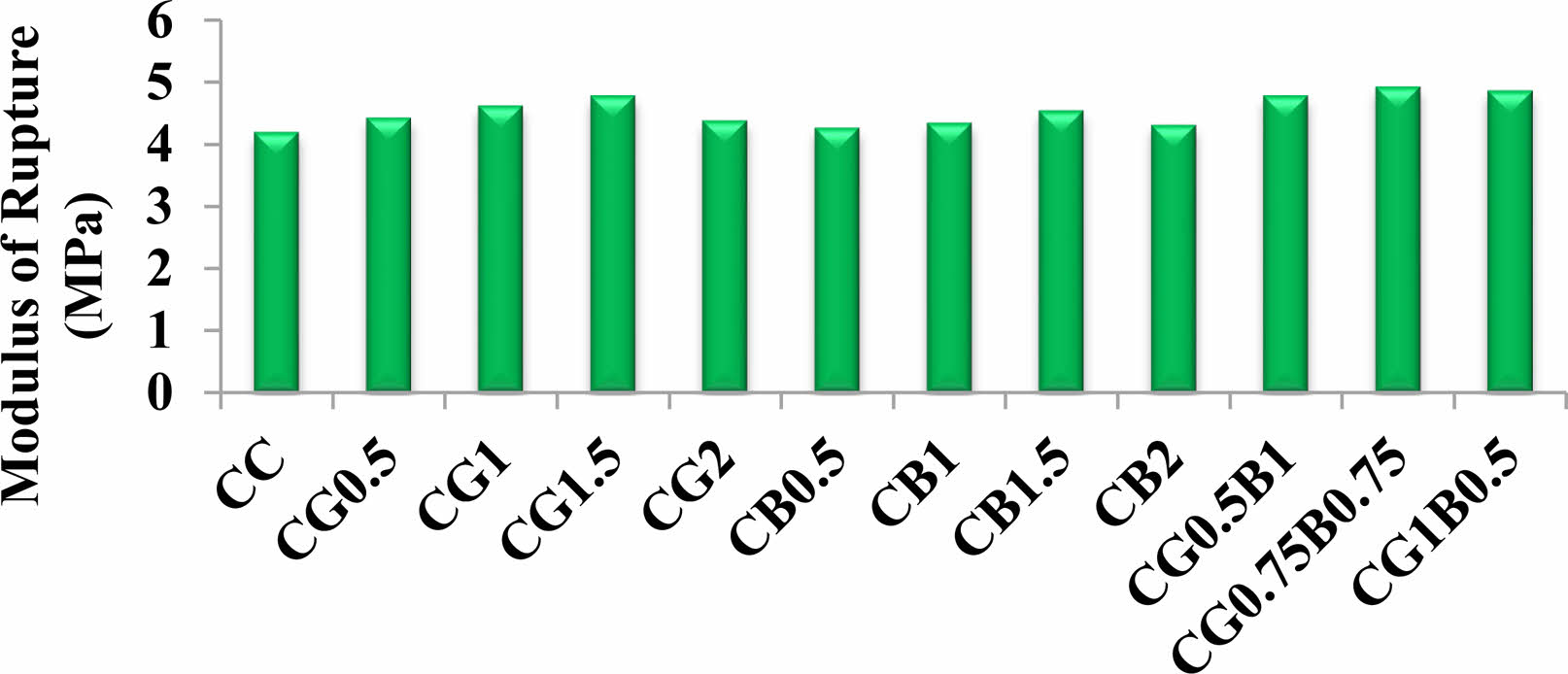
Flexural Behavior of hybrid fiber reinforced Concrete Beams
From the mechanical properties tests, the hybrid concrete fibers specimens have better performance. This article has covered the flexibility of hybrid fibre reinforced concrete beams. The conventional concrete specimen has the first crack load at 7.5 kN and the deflection corresponding to the first crack load is 6.4 mm. The yield load occurs at 30.3 kN and the deflection corresponding to the yield load is 24.3 mm, Also the ultimate load value is 35.8 kN and the deflection corresponding to the ultimate load is 30.1 mm.
The CG0.5B1.0 concrete specimen has the first crack load at 9.4 kN and the deflection corresponding to the first crack load is 6.3 mm. The yield load occurs at 37.6 kN and the deflection corresponding to the yield load is 21.3 mm, Also the ultimate load value is 43.2 kN and the deflection corresponding to the ultimate load is 28.4 mm.
The CG0.75B0.75 concrete specimen has the first crack load at 12.8 kN and the deflection corresponding to the first crack load is 3.6 mm. The yield load occurs at 46.4 kN and the deflection corresponding to the yield load is 20.6 mm, Also the ultimate load value is 49.4 kN and the deflection corresponding to the ultimate load is 24.3 mm.
The CG1.0B0.5 concrete specimen has the first crack load at 11.1 kN and the deflection corresponding to the first crack load is 3.1 mm. The yield load occurs at 42.0 kN and the deflection corresponding to the yield load is 23.5 mm, Also the ultimate load value is 48.3 kN and the deflection corresponding to the ultimate load is 27.1 mm.
The beams of hybrid fiber reinforced concrete obey the hooks law. Because it have linear stress strain relationship and the formation and prolonging of cracks under control of fibers. These beams were resisted the load and the deflection in a linear way.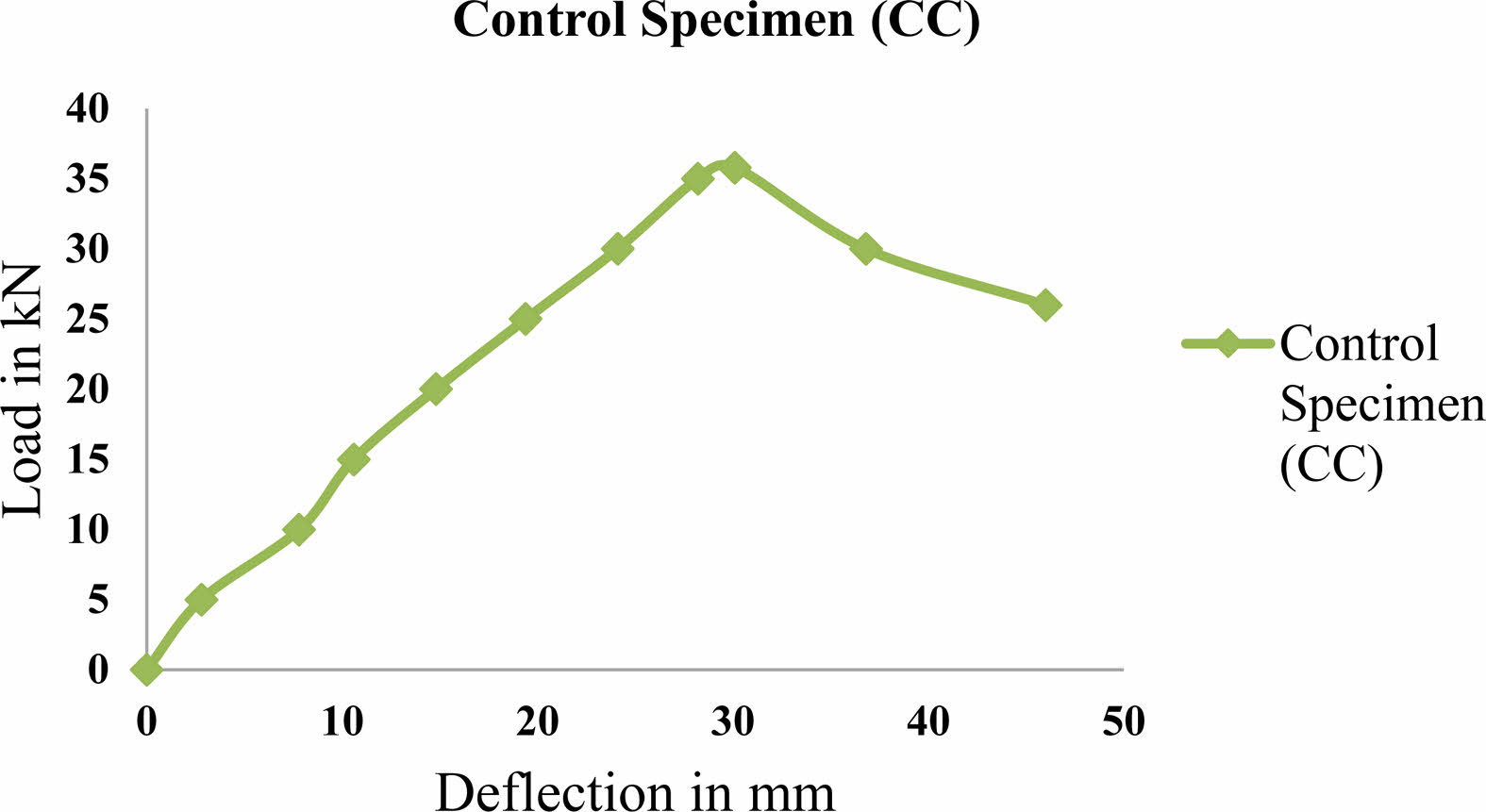
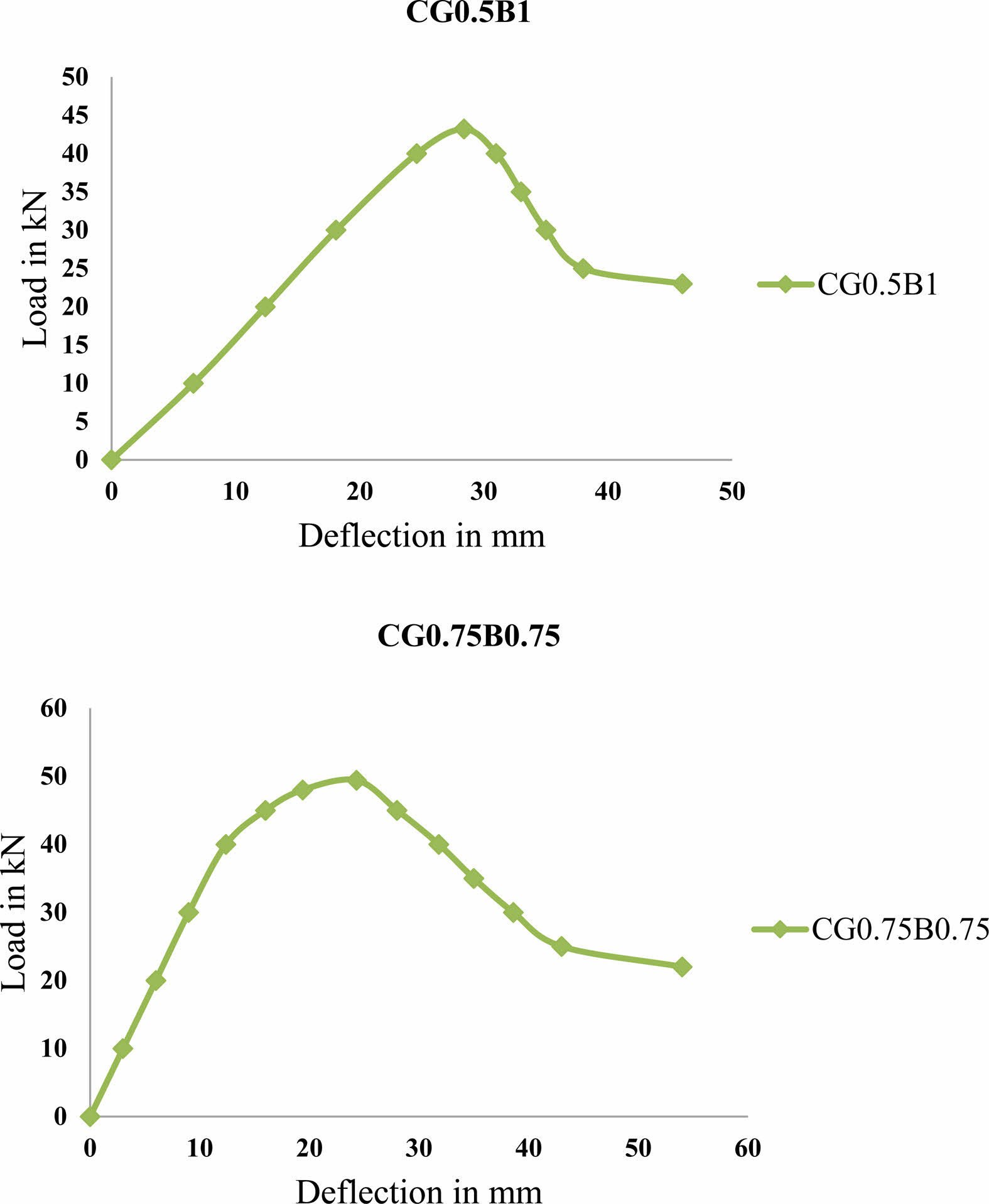
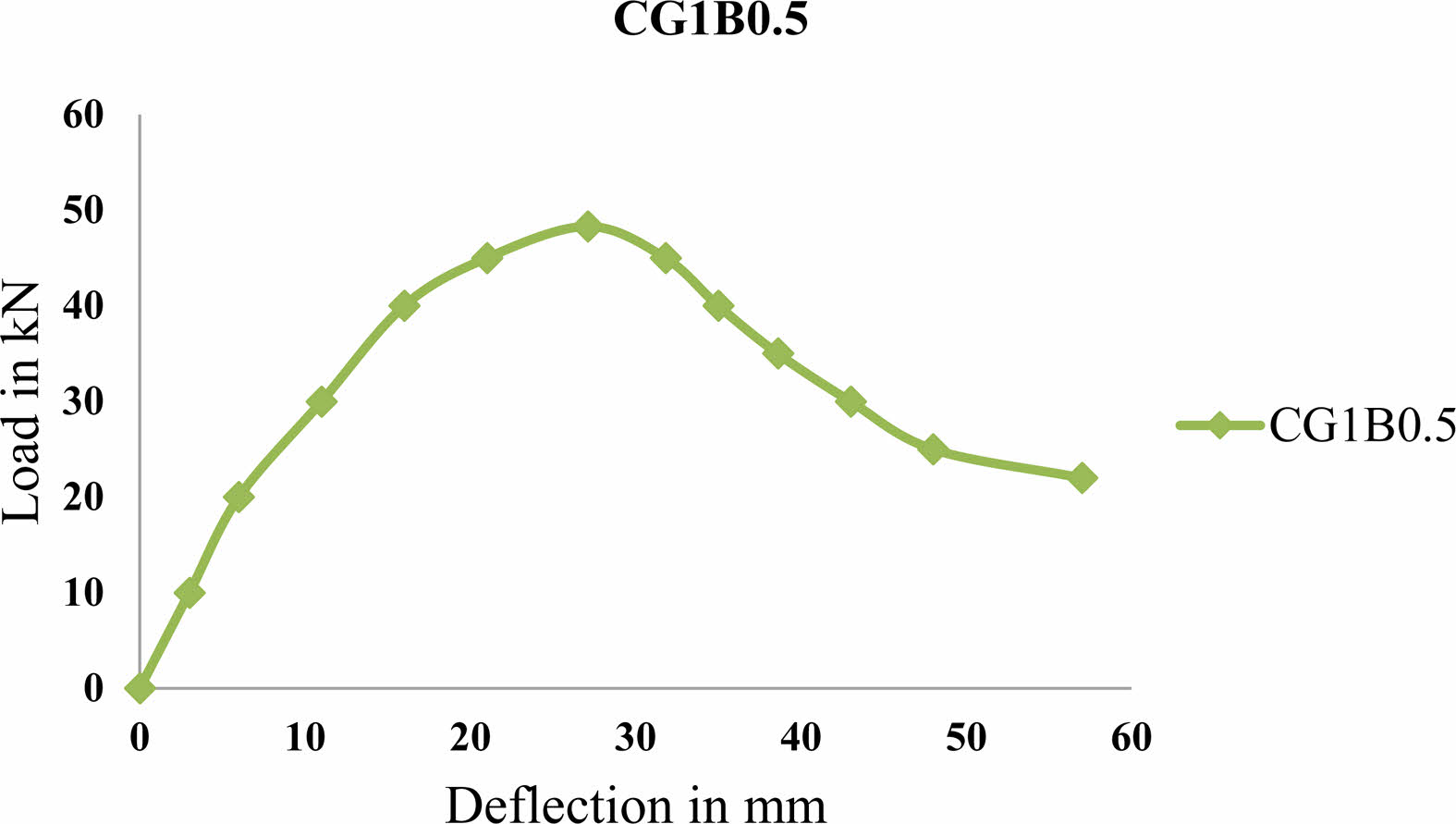

Acid Attack
After 28 days of water curing, the CC specimen's elastic modulus is 34.6 MPa. Similarly the CG0.5, CG1.0, CG1.5, CG2.0, CB0.5, CB1.0, CB1.5, CB2.0, CG0.5B1.0, CG0.75B0.75 & CG1.0B0.5 has the values of compressive strength as 35.8, 36.7, 37.6, 37.3, 35.6, 36.4, 37.1, 36.9, 37.5, 38.4 & 37.9 MPa. After 30 days of acid attack, the value of compressive strength is reduced by 7.2, 4.7, 4.9, 4.3, 4.8, 5.4, 5.8, 4.6, 5.1, 4.3, 3.6 & 4.5%. Further, the strength was reduced by 12.1, 10.9, 11.4, 11.2, 11.4, 11.0, 11.3, 10.0, 10.2, 8.7, 8.1 & 8.2% for 60 days of acid attack for 28 days of water curing. Further, the strength is reduced by 15.6, 14.8, 14.7, 14.1, 14.6, 15.0, 15.1, 14.8, 15.1, 13.6, 13.3 & 13.8% for 90 days of acid attack for A 28-day water-curing period.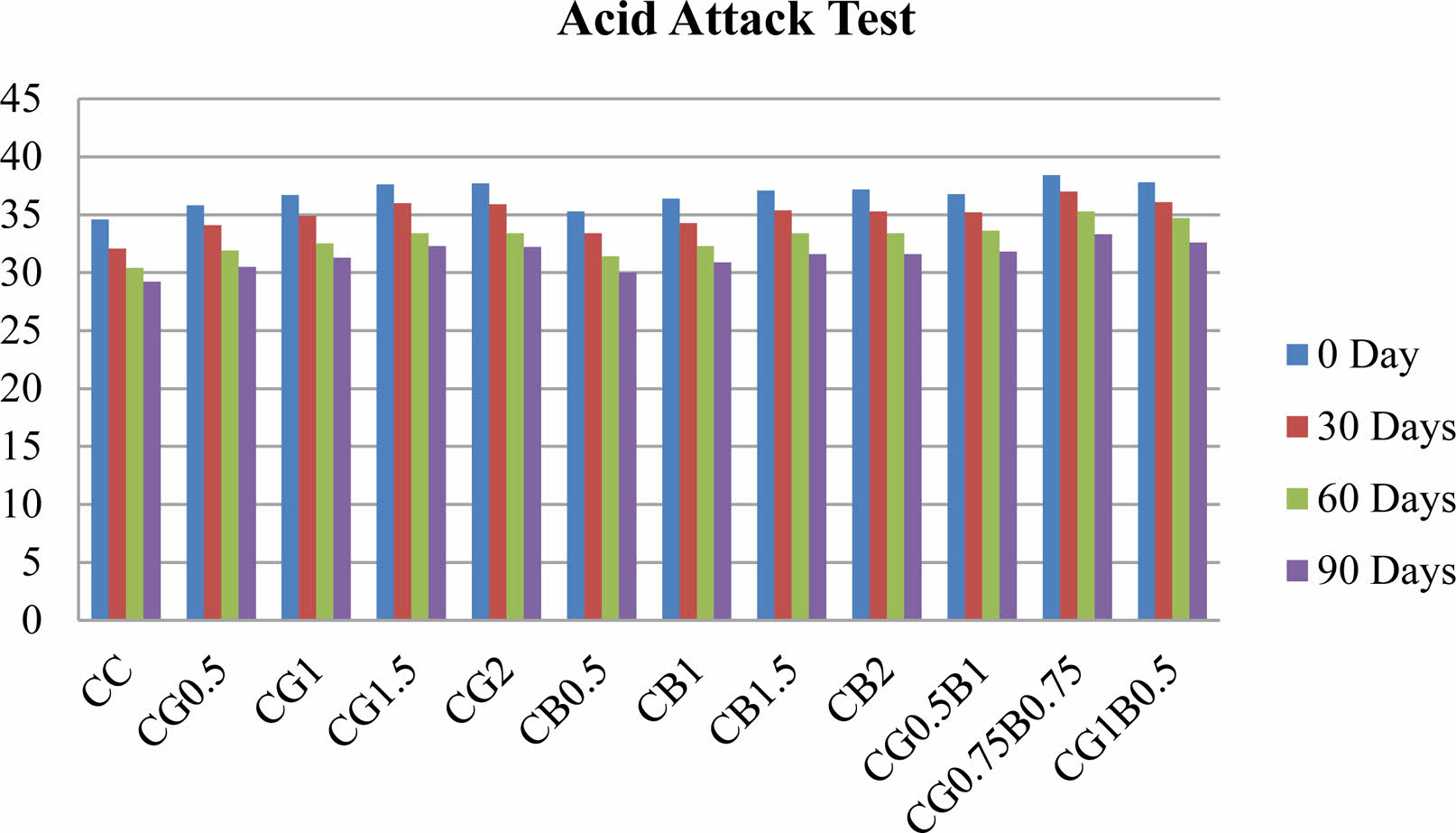
Sulphate Attack
After 28 days of water curing, the CC specimen's elastic modulus is 34.6 MPa. Similarly the CG0.5, CG1.0, CG1.5, CG2.0, CB0.5, CB1.0, CB1.5, CB2.0, CG0.5B1.0, CG0.75B0.75 & CG1.0B0.5 has the values of compressive strength as 35.8, 36.7, 37.6, 37.3, 35.6, 36.4, 37.1, 36.9, 37.5, 38.4 & 37.9 MPa. After 30 days of sulphate attack, the value of compressive strength is reduced by 7.5, 5.9, 5.7, 4.8, 5.0, 6.2, 6.3, 5.7, 6.2, 4.9, 4.7 & 5.0%. Further, the strength was reduced by 13.0, 11.5, 11.7, 11.4, 11.9, 12.2, 12.4, 11.6, 11.8, 9.5, 9.1 & 9.8% for 60 days of sulphate attack for 28 days of water curing. Further, the strength is reduced by 18.8, 15.9, 15.3, 15.2, 15.6, 16.7, 16.2, 15.9, 16.4, 14.4, 13.8 & 14.3% for Twenty-eight days for a water cure followed by ninety hours of attack by sulfate.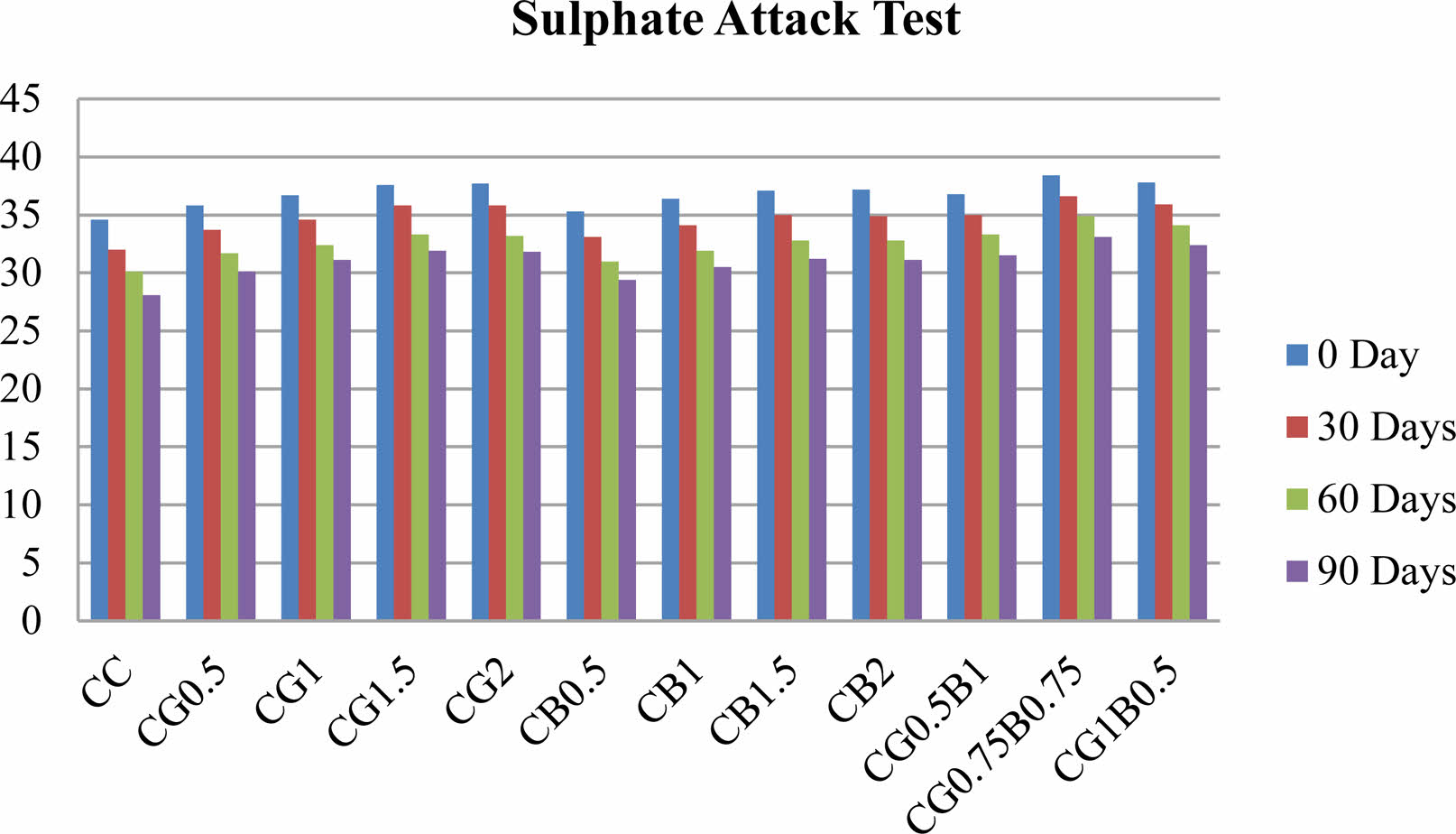
Chloride Attack
After 28 days of water treatment, the CC specimen's strength at compression is 34.6 MPa. Similarly the CG0.5, CG1.0, CG1.5, CG2.0, CB0.5, CB1.0, CB1.5, CB2.0, CG0.5B1.0, CG0.75B0.75 & CG1.0B0.5 has the values of compressive strength as 35.8, 36.7, 37.6, 37.3, 35.6, 36.4, 37.1, 36.9, 37.5, 38.4 & 37.9 MPa. After 30 days of chloride attack, the value of compressive strength is reduced by 7.4, 5.3, 5.3, 4.5, 4.9, 5.8, 6.0, 5.1, 5.6, 4.6, 4.2 & 4.8%. Further, the strength was reduced by 12.6, 11.2, 11.6, 11.3, 11.7, 11.6, 11.8, 10.8, 11.0, 9.1, 8.6 & 9.0% for 60 days of chloride attack for 28 days of water curing. Further, the strength is reduced by 17.2, 15.4, 15.0, 14.6, 15.1, 15.9, 15.7, 15.4, 15.7, 14.0, 13.5 & 14.0% for 90 days of chloride attack for 28 days of water curing.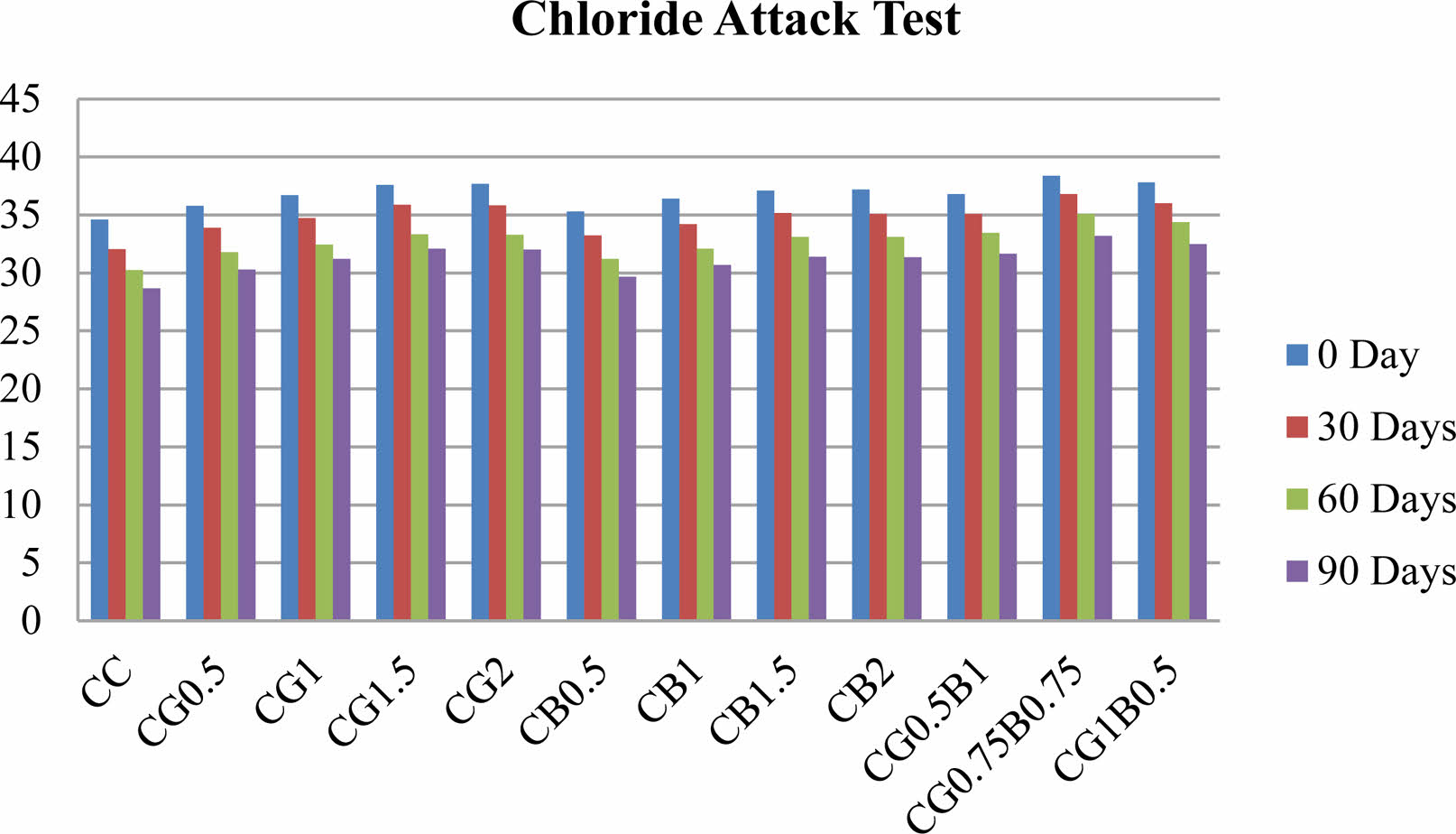
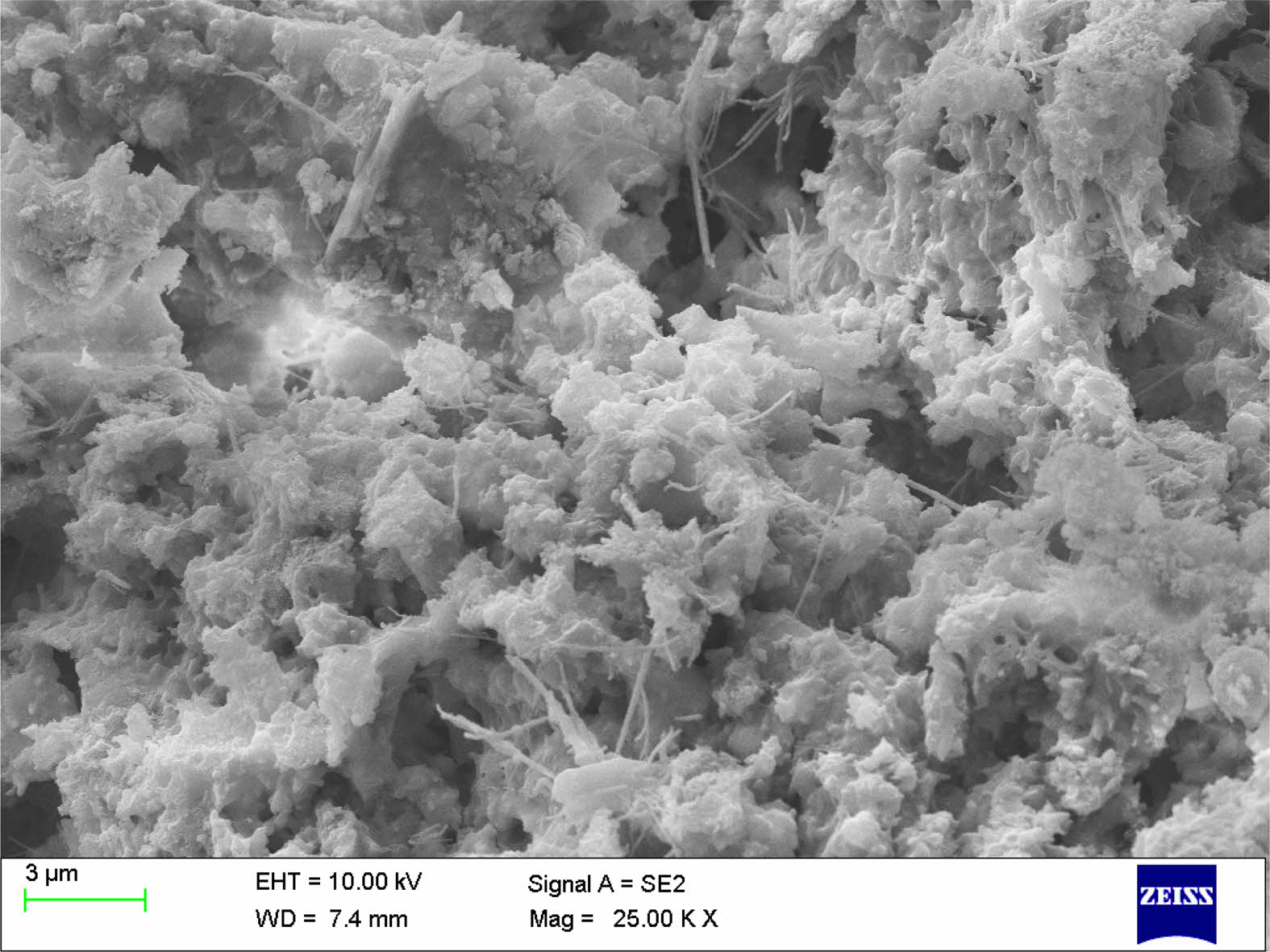
|
Fig. 8 SEM morphology of hybrid fiber concrete. |
Based on the tests of mechanical characteristics
● The concrete, when adding the Glass fiber, the 1.5% of volume fraction possesses, a good strength of 37.6 MPa and the basalt fiber of 1.5% possesses, a strength of 37.1 MPa. These values of strength are 8.7% and 7.2% greater than that of ordinary concrete particle strength.
● Every 0.75% volume portion of hybrid fiber has a stronger durability of 38.4 MPa, which is 11% more than the breaking strength of the ordinary concrete specimen.
● Split strength of concrete, when adding the Glass fiber, the 1.5% of volume fraction possesses a good strength of 4.42 MPa and the basalt fiber of 1.5% possesses, a strength of 4.34 MPa. These values of strength are 12.8% and 10.7% greater than that of normal concrete sample durability.
● The hybrid fiber of each 0.75% of volume fraction possesses a better strength of 4.41 MPa and it is 12.5% more than the strength of the conventional concrete specimen.
● Modulus of rupture strength of concrete, when adding the Glass fiber, the 1.5% of volume fraction possesses good strength of 4.78 MPa and the basalt fiber of 1.5% possesses a strength of 4.54 MPa. These values of strength are 14.1% and 8.4% greater than that of standard concrete examples.
● The hybrid fiber of each 0.75% of volume fraction possesses better strength of 4.92 MPa and it is 17.4% exceeding the standard concrete specimen's strength.
● Addition of fibers gives good resistance against the applied load and its hybridization, and the properties of concrete have increased significantly.
From the static load test,
● The beams of hybrid fiber reinforced concrete obey the hooks law. Because it has the linear stress-strain relationship and the formation and prolonging of cracks under the control of fibers. These beams have resisted the load and the deflection in a linear way
From the durability test,
● The additions of fibers have good resistance against adverse environmental conditions. The acid attack of 90 days has the highest percentage of reduction of the strength of 15.6%, corresponding to sulphate attack at 18.8% and corresponding to chloride attack at 17.2% by CC.
- 1. R. Yu, P. Spiesz, and H.J.H. Brouwers, Constr. Build. Mater. 68[15] (2014) 158-171.
-

- 2. D.Y. Su, J.Y. Pang, and X.W Huang, Hindawi, Ad. Civil. Eng. (2021) 15.
-

- 3. N.K. Amudhavalli and M. Harihanandh, Int. J. Eng & Tech. 7[3] (2018) 1544-1547.
-

- 4. Q. Zaman Khan, Iranian J. Sci. Tech. Trans. Civil Eng. (2022).
-

- 5. J. Feng, W. Sun, H. Zhai, L. Wang, H. Dong, and Qi Wu, Mat. (Basel). 11[12] (2018) 2563.
-

- 6. M.A. Yusof, N.M. Nor, A. Ismail, N.C. Peng, R.M. Sohaimi, and M.A. Yahya, Hindawi Pub. Cor. Ad. Mat. Sci. Eng. (2013) 7.
-

- 7. AR. Krishnaraja and S. Kandasamy, Arch. Civil Eng. 63[4] (2017) 173-189.
-

- 8. B. Wang, R. Fang, and Q. Wang, Hindawi Adv. Civil Eng. (2020) 17.
-

- 9. Y. Wang, X. Shao, J. Cao, X. Zhao, and M. Qiu, Eng. Struct. 231[15] (2021) 111728.
-

- 10. M.A. Aiello and L. Ombres, J. Compos. Constr. (2002) 133-140.
-

- 11. S. Anandaraja, A.R. Krishnarajab, P. Kulanthaivelc, and P.C. Murugand, J. Ceram. Process. Res. 25[1] (2024) 41-47.
-

- 12. Z. Tonga, C. Xua, J. Wanga, and Z. Jiab, J. Ceram. Process. Res. 24[1] (2023) 17-28.
-

- 13. Z. Chen, J. Zhao, P. Lia, A. Qina, Z. Gao, W. Zhao, S. Wang, and G. Lia, J. Ceram. Process. Res. 24[1] (2023) 40-50.
-

- 14. S. Hussain, and J.S. Yadav, J J Civil Eng. 17[2] (2023).
-

- 15. A. Paktiawal, and M. Alam, M., Mater Today-Proc 47 (2021) 4758-4766.
-

- 16. Indian Standard IS 10262: 2019, Concrete Mix Proportioning - Guidelines, Bur. Ind. Std, New Delhi, India.
- 17. Indian Standard, IS8112: Ordinary Portland Cement, 43 Grade - Specification, New Delhi, Bur. Ind. Std, 2013.
- 18. Indian Standard, IS383: Specification For Coarse And Fine Aggregates From Natural Sources For Concrete, New Delhi, Bur. Ind. Std, 1970
- 19. Indian Standard. IS2386 (Part I): Methods Of Test For Aggregates For Concrete Part I Particle Size and Shape, New Delhi, Bur. Ind. Std, 1963.
- 20. Indian Standard, IS2386 (Part III): Methods of Test for Aggregates for Concrete Part III - Specific Gravity, Density, Voids, Absorption and Bulking, New Delhi, Bureau of Ind. Std, 1963.
- 21. Indian Standard, IS456, Plain and Reinforced Concrete - Code of Practice, New Delhi, Bu. Ind. Std, 2000.
- 22. Indian Standard, IS5816, Splitting tensile strength of concrete – Method of test, New Delhi, Bur. Ind. Std, 1999.
- 23. Indian Standard, IS516, Methods of tests for strength of concrete, New Delhi, Bur. Ind. Std, 1959.
- 24. M. Harihanandh, K.E. Viswanathan, and A.R. Krishnaraja, Mat. Proc. 45 (2021) 3132-3136.
-

- 25. M. Harihanandh, K. Karuppanan, K.E. Viswanathan, and A.R. Krishnaraja, Rev. Mat. 28[4] (2023) p.e20230281.
-

 This Article
This Article
-
2024; 25(4): 521-528
Published on Aug 31, 2024
- 10.36410/jcpr.2024.25.4.521
- Received on Jan 13, 2024
- Revised on May 10, 2024
- Accepted on Jun 12, 2024
 Services
Services
- Abstract
introduction
materials and mix proportion
experimental investigation
result and discussion
conclusion
- References
- Full Text PDF
Shared
 Correspondence to
Correspondence to
- S. Christian Johnson
-
Professor, Department of Civil Engineering, Erode Sengunthar Engineering College, Erode, Tamil Nadu, India
Tel : +91 97881 97761 - E-mail: christianjohnson98@gmail.com






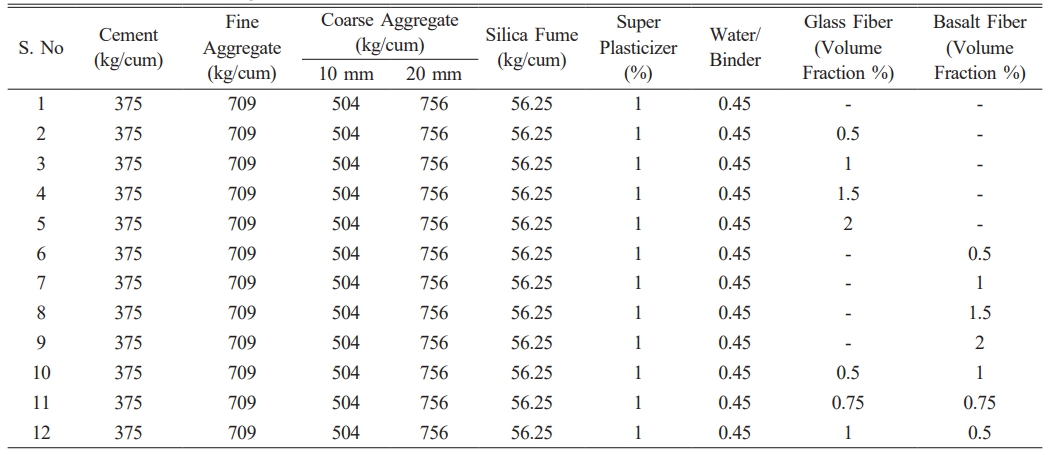
 Copyright 2019 International Orgranization for Ceramic Processing. All rights reserved.
Copyright 2019 International Orgranization for Ceramic Processing. All rights reserved.